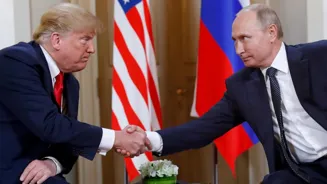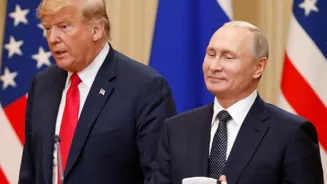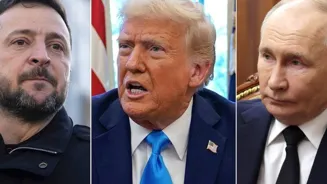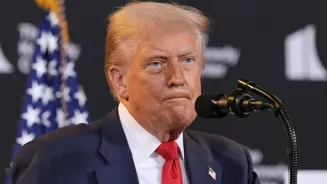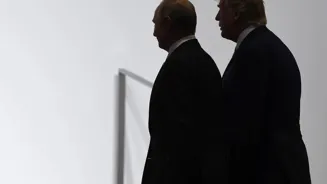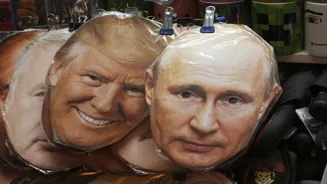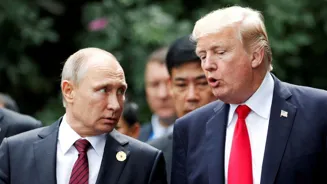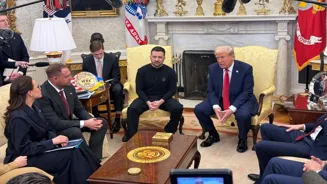What is the story about?
The much-hyped Alaska meeting between US President Donald Trump and Russian President Vladimir Putin concluded with no ceasefire, no agreement, and no concrete pathway toward ending the Russia–Ukraine war. For all the
showmanship—a warm tarmac greeting, twin handshakes, and a joint limo ride—the summit produced little more than vague assurances, cryptic references to “progress”, and a reminder that when it comes to this war, “there’s no deal until there’s a deal”.
Outcome: All Optics, No Substance
After nearly three hours behind closed doors, Trump conceded, “We didn’t get there”, before exiting without taking questions. His earlier claim that there was only a “25 per cent chance” of failure now looks like a self-inflicted blow to his credibility as a
self-styled peacemaker and dealmaker.
Putin described himself as “sincerely interested” in ending what he called a “tragedy” but offered no specifics. He warned against “sabotage” by Ukraine and Europe and insisted that “primary causes” of the conflict must be addressed—Kremlin code for its longstanding demands on arresting Nato expansion and ensuring territorial recognition of the territory gained. Apparently Putin did not compromise on any of his demands and handled Trump with his vast diplomatic experience, leaving a window for further talks.
Trump, for his part, said, “Many points were agreed to,” but admitted that “one significant” disagreement remained, without disclosing what it was. His pledge to call Ukrainian President Volodymyr Zelenskyy and European leaders “soon” was small consolation to Kyiv, which had been excluded from the talks. Putin’s parting words—“Next time in Moscow”—hinted at a possible sequel, but there’s no sign of a trilateral summit involving Ukraine.
War Aims and Strategic Calculus
Russia’s goals have been
consistent since the beginning and were not compromised, namely: solidify territorial control over captured regions, prevent Nato’s eastward expansion, no Nato membership for Ukraine, no militarisation of Ukraine and secure sanctions relief. The Alaska summit was an opportunity to appear diplomatic without making binding concessions.
Kyiv insisted on restoring territorial integrity and rejecting any “land-for-peace” swaps. Zelenskyy will find some consolation there, as his land was not swapped, although no agreement on a
ceasefire will not reduce his pain.
Trump sought a personal win—a headline-grabbing breakthrough he could sell at home. The optics were managed to portray warmth and progress, but in substance, he leaves Alaska with neither a deal nor increased diplomatic leverage.
Pre-Negotiation Positions
Russia entered willing to talk ceasefire terms but only under conditions preserving military gains. It exhibited strategic maturity by not responding to President Trump’s rhetoric of ‘severe consequences if no ceasefire’ but stuck to its
position. Ukraine was opposed to any talks that exclude Kyiv and refused concessions on sovereignty and territorial integrity, which made the ceasefire prospects near impossible.
The US pursued exploratory diplomacy, with Trump hinting at creative solutions—including unspecified compromises—that alarmed some allies. During the pre-negotiation stage, Trump’s stance was inconsistent between pragmatism, rhetoric, the influence of the US deep state and last-day pressure from European counterparts and Ukraine. Putin thus entered the negotiations
from a position of strength with clarity on the outcome.
Implications of Failure
For Ukraine, the inconclusive outcome is a mixed blessing—no dangerous unilateral deal, but also no relief from daily shelling. For Russia, the meeting offered propaganda value: Putin stood beside the US president as an equal, reinforcing his legitimacy on the world stage. For Trump, the optics of coming home empty-handed after promising a breakthrough will sting. The “25 per cent failure” threshold he set has become a self-own, inviting criticism from both allies and adversaries.
Internationally, the summit leaves the war right where it was—grinding on in the trenches—while signalling that Washington is willing to engage Moscow directly, even without Ukraine in the room. That precedent could shape future diplomacy in ways that European members of Nato and Kyiv may find troubling.
What’s Next?
The summit outcome doesn’t stop Putin from continuing Russian aggression to improve ground position in its favour. The outcome could see intermittent backchannel talks and another high-profile but low-yield
summit. The absence of a flawed deal could keep Nato unity intact with renewed pressure on sanctions and tariffs. The risk remains that repeated summits without progress may erode US credibility and give Moscow breathing space to regroup militarily.
The dissatisfied Nato and Ukraine will expect President Trump to act on secondary tariffs, sanctions and military support to Ukraine, but that might jeopardise any undeclared gains in the Alaska Summit for President Trump, if there are any. Putin’s confidence in this summit is a direct reflection
of his strong position on the battlefield, which gives him more leverage than Nato. Ukraine or Europe don’t hold any card to dictate terms to Russia, and their position is unlikely to change without full support of the US.
Conclusion
The Alaska summit was billed as a possible turning point in the Russia–Ukraine war; instead, it was a carefully choreographed non-event. Trump’s showmanship produced good optics but no substance, Putin pocketed the legitimacy boost without paying in concessions, and Ukraine was left to watch from the sidelines.
In diplomacy, sometimes no deal is better than a bad one—but for battered Ukraine, “no deal” also means no relief. The danger now is that repeated inconclusive engagements will normalise a frozen conflict, giving Moscow an edge earned by battlefield successes. For countries affected by secondary tariffs/sanctions, the risk remains!
The author is a strategic and security analyst. He can be reached at Facebook and LinkedIn as Shashi Asthana, @asthana_shashi on Twitter, and personal site. Views expressed in the above piece
are personal and solely those of the author. They do not necessarily reflect Firstpost’s views.
Outcome: All Optics, No Substance
After nearly three hours behind closed doors, Trump conceded, “We didn’t get there”, before exiting without taking questions. His earlier claim that there was only a “25 per cent chance” of failure now looks like a self-inflicted blow to his credibility as a
Putin described himself as “sincerely interested” in ending what he called a “tragedy” but offered no specifics. He warned against “sabotage” by Ukraine and Europe and insisted that “primary causes” of the conflict must be addressed—Kremlin code for its longstanding demands on arresting Nato expansion and ensuring territorial recognition of the territory gained. Apparently Putin did not compromise on any of his demands and handled Trump with his vast diplomatic experience, leaving a window for further talks.
Trump, for his part, said, “Many points were agreed to,” but admitted that “one significant” disagreement remained, without disclosing what it was. His pledge to call Ukrainian President Volodymyr Zelenskyy and European leaders “soon” was small consolation to Kyiv, which had been excluded from the talks. Putin’s parting words—“Next time in Moscow”—hinted at a possible sequel, but there’s no sign of a trilateral summit involving Ukraine.
War Aims and Strategic Calculus
Russia’s goals have been
Kyiv insisted on restoring territorial integrity and rejecting any “land-for-peace” swaps. Zelenskyy will find some consolation there, as his land was not swapped, although no agreement on a
Trump sought a personal win—a headline-grabbing breakthrough he could sell at home. The optics were managed to portray warmth and progress, but in substance, he leaves Alaska with neither a deal nor increased diplomatic leverage.
Pre-Negotiation Positions
Russia entered willing to talk ceasefire terms but only under conditions preserving military gains. It exhibited strategic maturity by not responding to President Trump’s rhetoric of ‘severe consequences if no ceasefire’ but stuck to its
The US pursued exploratory diplomacy, with Trump hinting at creative solutions—including unspecified compromises—that alarmed some allies. During the pre-negotiation stage, Trump’s stance was inconsistent between pragmatism, rhetoric, the influence of the US deep state and last-day pressure from European counterparts and Ukraine. Putin thus entered the negotiations
Implications of Failure
For Ukraine, the inconclusive outcome is a mixed blessing—no dangerous unilateral deal, but also no relief from daily shelling. For Russia, the meeting offered propaganda value: Putin stood beside the US president as an equal, reinforcing his legitimacy on the world stage. For Trump, the optics of coming home empty-handed after promising a breakthrough will sting. The “25 per cent failure” threshold he set has become a self-own, inviting criticism from both allies and adversaries.
What’s Next?
The summit outcome doesn’t stop Putin from continuing Russian aggression to improve ground position in its favour. The outcome could see intermittent backchannel talks and another high-profile but low-yield
The dissatisfied Nato and Ukraine will expect President Trump to act on secondary tariffs, sanctions and military support to Ukraine, but that might jeopardise any undeclared gains in the Alaska Summit for President Trump, if there are any. Putin’s confidence in this summit is a direct reflection
Conclusion
The Alaska summit was billed as a possible turning point in the Russia–Ukraine war; instead, it was a carefully choreographed non-event. Trump’s showmanship produced good optics but no substance, Putin pocketed the legitimacy boost without paying in concessions, and Ukraine was left to watch from the sidelines.
The author is a strategic and security analyst. He can be reached at Facebook and LinkedIn as Shashi Asthana, @asthana_shashi on Twitter, and personal site. Views expressed in the above piece
Do you find this article useful?


